
Oui, Oui, Marie is a 1918 song performed by Arthur Fields. The music was composed by Fred Fisher with lyrics written by Alfred Bryan and Joe McCarthy. It was published by McCarthy & Fisher Inc. The sheet music cover featured an illustration by Andre De Takacs. The song reached a peak position of No.2 on Top 100 US Songs of 1918.
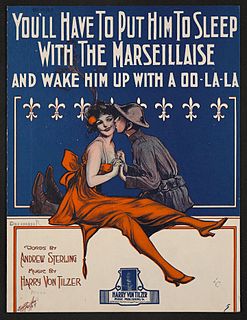
You'll Have to Put Him to Sleep with the Marseillaise and Wake Him Up with a Oo-La-La is a World War I song written in 1918. Andrew B. Sterling wrote the lyrics, and Harry Von Tilzer composed the music. The song was produced by the Harry Von Tizler Publishing Company in New York City. On the cover of the sheet music is a soldier kissing a woman. The song was written for both voice and piano.
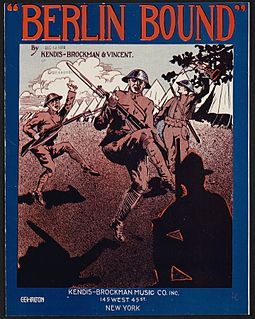
Berlin Bound is a World War I song written in 1918. The lyrics and music were written by James Kendis, James Brockman, and Nat Vincent. Kendis Brockman Music Co. published the song in New York, New York. On the cover of the sheet music is a drawing of soldiers dancing. The piece was written for both voice and piano.
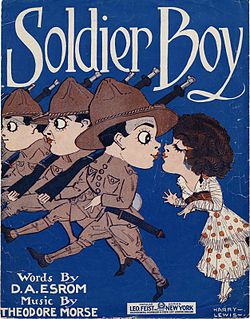
Soldier Boy is a World War I era song released in 1915. D.A. Esrom wrote the lyrics. Theodore Morse composed the music. Leo Feist, Inc. of New York, New York published the song. Artist Harry Lewis designed the cover art for the sheet music. On the cover, there are three cartoon soldiers. One has his head turned to kiss a woman behind him. The song was written for both voice and piano. It is told from the point of view of a woman who is proud of her soldier boy. She addresses the soldier directly in the chorus:

I'm Writing to You, Sammy is a World War I era song released in 1917. Lew Brown wrote the lyrics. Al Harriman composed the music. The song was published by Broadway Music Company of New York, New York. On the cover of the sheet music is a drawing of a soldier, from the shoulders up, inside of a star. Artist E.E. Walton designed the cover. The song was written for both piano and voice.
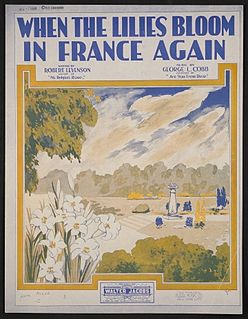
"When the Lilies Bloom in France Again" is a World War I era song released in 1918. Robert Levenson wrote the lyrics. George L. Cobb composed the music. It was published by Walter Jacobs of New York City and Boston, Massachusetts. There are two versions of the sheet music cover. One was designed by Rose Starmer. The cover is described as an "artistic words only cover." Another cover is a painting of a garden, with lilies in the foreground. The song was written for both voice and piano.

"I'm Goin' To Fight My Way Right Back to Carolina" is a World War I era song written and composed by Billy Baskette and Jessie Spiess. The song was published in 1918 by McCarthy & Fisher, Inc. of New York, New York. The sheet music cover was designed by Andre C. De Takacs. It features an armed soldier tearing through the cover. The song was written for both voice and piano.
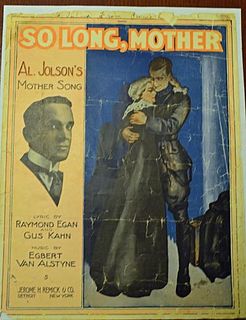
"So Long, Mother" is a World War I era song released in 1917. Raymond B. Egan and Gus Kahn wrote the lyrics. Egbert Van Alstyne composed the music. The song was published by Jerome H. Remick & Co. of Detroit, Michigan. On the cover is a soldier and mother in an embrace. To the left is an inset photo of singer Al Jolson. It was written for both voice and piano.

"Lorraine " is a World War I era song released in 1917. Al Bryan wrote the lyrics. Fred Fisher composed the music. It was published by McCarthy and Fisher, Inc.. André De Takacs designed the sheet music cover. It features a French soldier with his bayonet drawn in the foreground. A woman, who is a symbol of Liberty, and child look on behind him. The song was written for voice and piano.

"And He'd Say, 'Oo-La-La! Wee-Wee!'" is a World War I era song released in 1919. Lyrics and music were written by George Jessel and Harry Ruby. William Baker arranged the song. It was published by Waterson, Berlin & Snyder, Inc. of New York, New York. The song was written for voice and piano.
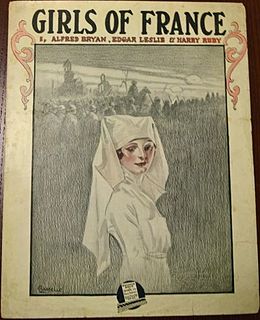
"Girls of France" is a World War I era song released in 1917. Al Bryan and Edgar Leslie wrote the lyrics. Harry Ruby composed the music. The song was published by Waterson, Berlin & Snyder Co. of New York, New York. Artist Albert Wilfred Barbelle designed the sheet music cover. It features a nurse in the foreground, and soldiers marching behind her. It was written for both voice and piano.
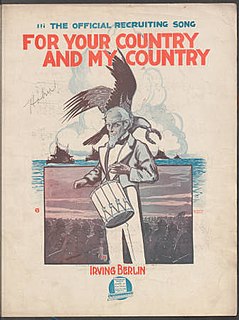
"For Your Country and My Country" is a World War I era song released in 1917. Lyrics and music were written by Irving Berlin. The song was published by Waterson, Berlin & Snyder, Co. of New York, New York. Artist Albert Wilfred Barbelle designed the sheet music cover. It features Uncle Sam playing a snare drum with an eagle on his shoulder. In the background are ships sailing, and below are troops marching. Above the title, it reads, "The Official Recruiting Song." The song was written for voice and piano, along with chords for guitar, ukulele, and banjo.
"Lafayette " is a World War I song written and composed by Mary Earl, which was a pseudonym of Robert A. King. It was published in New York, New York by Shapiro, Bernstein, & Co. in 1918. The sheet music cover, illustrated by Albert Barbelle, depicts soldiers marching with fixed bayonets below a statue of Lafayette in silhouette.
Good-Bye France is a World War I song written by Irving Berlin. It was published in 1918 by Waterson, Berlin & Snyder C., in New York, NY. The sheet music cover, illustrated by Albert Barbelle, features French and American soldiers shaking hands with the Statue of Liberty in the background.
"I'll See You Later Yankeeland" is a World War I song written and composed by Charles K. Harris. The song was self-published in 1917 by Charles K. Harris in New York, NY. The sheet music cover features a photo of soldiers waving from the deck of a ship.

"I'm Giving You To Uncle Sam" is a World War I song written by Thomas H. Ince and composed by Victor Schertzinger. The song was published in 1918 by Southern California Music in Los Angeles, CA. The sheet music cover depicts soldiers charging out of a trench with the US Capitol and a flag in the background.

"Mother, Here's Your Boy!" is a World War I song written and composed by Sidney D. Mitchell, Archie Gottler, and Theodore Morse. This song was published in 1918 by Leo. Feist, Inc., in New York, NY. The sheet music cover depicts Uncle Sam presenting a returning soldier to his mother with the Statue of Liberty and ships in the background.
When I Come Back To You is a World War I song written and composed by William Tracey and Jack Stern. The song was first published in 1918 by Douglas & Newman Music in New York, NY.The sheet music cover depicts a soldier hugging a woman with the Liberty Bell in the background.
Let's All Be Americans Now is a World War I song written and composed by Irving Berlin, Edgar Leslie, and George W. Meyer. The song was first published in 1917 by Waterson, Berlin & Snyder Co., in New York, NY.The sheet music cover depicts a soldier with his rifle and silhouetted marching soldiers in the background. A popular recording in 1917 was made by the American Quartet.
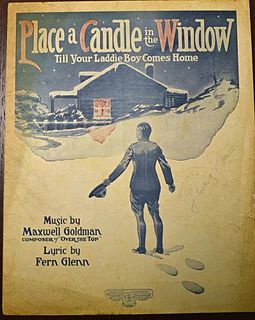
Place A Candle In the Window 'Till Your Laddie Boy Comes Home is a World War I song written by Fern Glenn and composed by Maxwell Goldman. The song was first published in 1918 by Buck & Lowney in New York, NY. The sheet music cover depicts a soldier returning to a snow covered house with a candle in the window.















